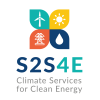Ahead of eight selected extreme weather events, the S2S4E team figured out how more reliable sub-seasonal to seasonal (S2S) forecasts can prevent economic losses for the energy sector, and improve both climate modellers' and traders' decision-making strategies.
With the 2020 European Sustainable Energy Week (EUSEW) happening this week, it is a great opportunity to focus on the recent analysis conducted by S2S4E partners in the deliverable D2.2 – Economic gains from using S2S forecasts in energy producers’ decision-making by analysing relevant case studies.
Extreme weather events were the starting prerequisite of the research carried out by S2S4E partners. Eight weather anomalies -in terms of temperature, wind or precipitation- which have affected the energy markets were selected and studied:
- Cold spell in France and Germany in 2017
- Heat wave and solar generation in Germany in 2013
- Heat wave and wind droughts in Spain in 2016
- Floods in Sweden in 2015
- Freezing event in Romania in 2014
- Wind droughts in USA in 2015
- Cold spell in France in 2018
- Record wind generation in Spain in 2018
All these extreme weather events caused unexpected fluctuations and volatility in energy demand, electricity generation and power prices. In addition, the increasing integration of renewable energy sources in the energy mix makes the power grid more vulnerable to climate variability and in need of more stability and high reliability, which is one of the main objectives of the S2S4E project. Overall, the S2S4E team notes that “efforts to make the current renewable energy technologies more resilient should be a priority in order to secure ongoing global prosperity”.
S2S forecasts: a potential game-changer?
Sub-seasonal to seasonal (S2S) forecasts used for the S2S4E analysis were provided by the S2S4E Decision Support Tool (DST). Launched in June 2019, this is an operational climate service that integrates for the first time S2S climate predictions with renewable energy production and electricity demand. The DST aims at providing more reliable and usable climate forecasts for weather dependent solar, wind and hydropower production.
Focusing mainly on three extreme weather events from those previously analysed (cold wave in France and Germany in 2017; freezing event in Romania in 2014; and cold spell in France and Europe in 2018), the S2S4E report highlights that renewable energy decision-makers see S2S forecasts as a potential game-changing instrument in supporting the energy transition. Indeed, although weather anomalies are not 100% under human control and cannot be avoided, risk management practices can be enhanced by improving forecasting tools and climate services.
S2S4E research has shown that when weather expectations don’t match observations, S2S forecasts can provide reliable information and prevent economic losses for companies in the energy sector: “S2S forecasts have a potential as a private good that is to provide data and information to users with specific needs, which they are willing to pay for”, indicated Hans Asbjørn Aaheim, senior researcher at the Norwegian Center for International Climate and Environmental Research (CICERO). “Beyond that, the forecasts have a value as a public good, for which analysis of the economic value perhaps is less important”, he added.
Directly benefitting energy producers and traders
Every day, energy producers have to communicate to the market the amount of energy they will deliver to the grid on the following day. In case of a wrong balance between demand and supply (power deviations), energy producers have to pay a penalty. Although financial decision-making processes in the energy market are complex and don’t only depend on weather, the S2S4E report shows that “sub-seasonal forecasts delivered by the DST could be useful to support financial decisions and operational and maintenance decisions, while seasonal forecasts serve budget planning”, explained Ilaria Vigo, environmental economist at the Barcelona Supercomputing Center (BSC), and one of the authors of the report.
Moreover, involving energy providers in the S2S4E analysis was “essential, partly to check our understanding of decision-making, and partly to tailor the information to their specific needs,” stressed Hans Asbjørn Aaheim.
In the case of the 2014 cold spell in Romania which caused power outages due to a shutdown of several wind farms, the S2S4E team found that an accurate sub-seasonal forecast would have enable the wind farm operators to make decisions nearly 10 days in advance, reducing then significantly the economic losses.
Regarding the two cold snaps analysed - occurring in France and Germany in 2017, and in France in 2018 -, the DST forecasts would have better valued the magnitude of these extreme events giving traders more time to implementing an efficient hedging strategy that would have estimated electricity prices more accurately.
Connecting climate modellers with users
To assess the economic value of S2S forecasts, S2S4E partners focused on how to make users understand how they can benefit from such forecasts. “Sub-seasonal forecasts help traders optimise their hedging strategies”, noted Ilaria Vigo. However, and on the other hand, “making a decisional error due to a change in the expectations led by a forecast concerns decision-makers more than gaining from the use of an informative forecast”, she pointed.
One key finding of the S2S4E study is that climate modellers should communicate their insights in a way that helps users understand why the weather deviates from what is expected whilst supporting them in making assessments of how much it will deviate.
Thanks to the S2S4E DST, partners are currently proceeding to a real test of the impact of operational forecasts on decision-making processes and these results will be available by the end of the S2S4E project.
Written by Mathilde Bazin-Retours (LGI)


